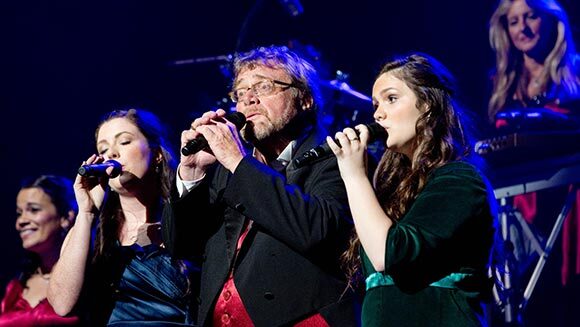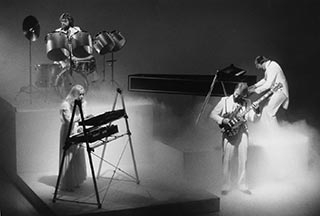Music man
The year 1965 marked a turning point for America and for an aspiring young musician named Chip Davis, BMus,’69.
That spring, U.S. President Lyndon Johnson launched a three-year bombing campaign on North Vietnam and sent the first American troops into combat. He also upped the U.S. draft quota, sparking anti-war protests on college campuses nationwide.
In the fall, Louis F. (Chip) Davis Jr., a small-town boy from Ohio ─ who was destined to become a legend in the music world ─ entered the University of Michigan to major in bassoon, following in the footsteps of his parents, both talented musicians who studied at U-M.
“There was a lot of turmoil on campus during the Vietnam era,” Davis recalls. “I wasn’t involved in that kind of stuff, because I was there for college. Besides, being in the Michigan Symphonic Band was like having a full-time job.”
While student activists chanted anti-war slogans at teach-ins, Davis spent his weekends sequestered for long hours in a practice room at the then-School of Music on North Campus, working on difficult bassoon passages in band pieces. “[Band Director William] Revelli was tough, and I knew he would go down the line and make you play your part,” Davis says. “It was terrifying to a certain degree.”
Thriller
Playing the cymbals in the then-all-male Michigan Marching Band also presented challenges for Davis, who got his early start in music by singing soprano in church and all-boy choirs. “[Assistant Band Director George Cavender] had been a Marine drill sergeant in World War II, and he was a stickler for precision,” Davis remembers. “On the practice field, we’d be standing on our right legs while he went around checking for a 90-degree angle on our left legs. It was all about discipline.”
Davis’ greatest thrill came the first time he emerged from the tunnel onto the football field at the Big House. “My dad, who played clarinet in the U-M band, told me, ‘Your knees are going to turn to jelly,’ and he was right,” Davis says. “It was a ‘wow experience’ to see 100,000 people in the stands. I was pretty awestruck.”
When he wasn’t practicing, Davis attended the annual May Festival performances by the Philadelphia Orchestra, sang in the University Musical Society’s Choir Union, chowed down at the Pretzel Bell restaurant, and quaffed 3.2 beers to the sound of English rock music in Toledo (Ohio) pubs strewn with peanut shells.
Davis, who recently threw a gala 70th-birthday party for himself on his 150-acre farm near Omaha, Neb., still chuckles about some of his mishaps at Michigan. Once he showed up at Hill Auditorium for a band performance, only to realize he’d left his music in his East Quad dorm room. “I had to play the whole concert from memory, although I probably cheated a little and peeked at another guy’s music,” Davis confesses.
Little did he realize after leaving Michigan in 1969 that he would become a trailblazer in New Age music and attract fans from around the world.
Home for the holidays
Today Davis is best known as the founder of Mannheim Steamroller, a 1970s-era New Age musical group, which has transformed holiday music with Davis’s signature “18th-century classical rock” renditions of popular Christmas songs. Since their first Christmas tour in 1984, Mannheim Steamroller has traveled 30 million miles and sold 40 million records worldwide. Their top-selling Christmas albums have featured such artists as singers Johnny Mathis and Olivia Newton-John, saxophonist Paul Winter, and the U-M’s Men’s Glee Club.“I have always liked Christmas music, but I was most interested in the Renaissance origins of Christmas carols,” Davis explains. “Hence, I wrote ‘Christmas Suite,’ which is a suite of four carols played on Renaissance instruments — that I played myself. That got me started on the first Christmas album.”
This year, Davis and his cohort of classically trained, rock-loving musicians will perform at the White House Christmas tree lighting ceremony for the third time, following similar gigs for Bill Clinton and George W. Bush during their presidencies. “We always get invited into the White House afterward for cookies and hot cocoa, and a quick photo with the President,” he says.
The biggest influence on Davis’ career as a composer was the emergence of new technology. “I came along at the beginning of synthesized music,” he says. “There was a big rabble in the classical community about synthesizers, which were viewed as cheap, copycat music. On the other side, the rock ‘n’ roll guys were putting down classical music. So I decided to cut down the center, and that’s when I came up with my idea for Fresh Aire, a music series that incorporates synthesized music alongside acoustic music.”
In the beginning
In the early 1970s, Davis “didn’t have two cents to rub together,” so he wrote music for advertising jingles produced by an Omaha-based ad agency in return for studio time. One of his clients, Bill Fries, hatched the idea for a fictitious singing truck driver named C.W. McCall and asked Davis to compose music for some catchy lyrics. Fries also became the gravelly voice of C.W. McCall, and their first song, “Old Home Filler Up and Keep on a Truckin’ Café,” quickly became a hit. A single release, “Convoy,” dovetailed with the CB radio craze of 1975 and was scooped up by millions of fans. The next year, Davis was named the Country Music Songwriter of the Year by the performing rights organization SESAC. Two years later, actor Kris Kristofferson played the lead role in the movie Convoy.
With money in his pocket, Davis ramped up production of Mannheim Steamroller’s nature-inspired Fresh Aire music series, a mash-up of authentic period instruments — such as harpsichords, lutes and recorders — and Moog synthesizers. He launched the American Gramophone record label in 1974 to distribute his albums after mainstream record companies turned him down, and won his first Grammy Award, for Fresh Aire 7, in 1991. At one concert in Omaha, Davis and his group played the opening set as Mannheim Steamroller, then changed their jackets backstage and reappeared as the featured C.W. McCall country band.
“I don’t think the audience even noticed it was the same five guys playing both sets,” he laughs.
One of Davis’ keepsakes is a photo taken with the late-actor Leonard Nimoy, a.k.a. Mr. Spock on the popular “Star Trek” television series. When they met at a Space Foundation event, Nimoy told him, “I’m a big fan of yours, and I have every album you ever made.” Davis says. “That blew me away.”
‘Share back’
With 19 gold, eight multi-platinum and four platinum-certified records, Davis ranks among an elite cadre of artists. Several years ago, Steve Shipps, a featured violinist with Mannheim Steamroller since its beginning, came to him with an unusual proposal. Shipps, now professor of violin and senior adviser to the Dean for International Study at the U-M School of Music, Theatre and Dance, asked Davis if he would donate money to build a multimedia innovation lab at the school.
“I decided it would be an exceptionally cool thing to do since I was in the first class to use the Music School building when it opened,” Davis says. In 2015, he contributed $1 million toward construction of the Chip Davis Technology Studio.
“I’m grateful that the training I received at Michigan helped to put me on my feet musically so I could do the things I do now and have a lot of success,” Davis says. “I wanted to share back.”








Ann Smith Mercandetti - 1968 and 1973
One note, please. The School of Music opened on the North Campus of the University of Michigan in the autumn of 1964. I was a freshman that year.
I love the photo of Chip Davis in his Michigan Marching Band uniform. My younger brother marched in the MMB (trumpet) in the autumns of 1966 and 1967, and I have photos of him which I took in front of the same building.
Chip was sort of “known” around the school before I graduated in 1968. Congratulations to Chip for his innovation and success!!
Reply
David Parker - 1974, 1979, 1983
I became a big fan of Mannheim Steamroller in the 70’s. Their Christmas music has become an integral part of the season in our home. It wasn’t until much later I learned that Chip Davis had been a previous music teacher at my son’s Junior High School here in Ohio. Thank you for this most interesting article on an innovative and talented musician.
Reply
Bruce Wilkison - 1983
I didn’t know much about Mannheim Steamroller the first time I was hired to play violin (UM School of Music BMus in Violin Performance, ’83) with them many years ago. I knew the contractor had also attended UM, with Chip. What a great experience! I’ve been a fan, especially of their Christmas/Holiday music, ever since. While most of the band has become a tad younger (as I’ve become much OLDER), I still regularly perform with them in Arizona. This year it’s 2 shows in Mesa and 2 in Tucson, and I can’t wait! They are a joy to work with. GO BLUE!!
Reply
Tami Miner - 1974
The first time I heard Chip Davis was at a Christmas concert in Salt Lake City, Utah. I fell in love with the music. I couldn’t get enough of it! Being a piano player myself, I watched the pianist intently! Looking down at my hands, they were mimicking her moves all through the concert. I ran to the music store and bought sheet music for what I had heard. Then more sheet music and more. Thanks for introducing me into your wonderful world! I think you and your artists are on the level of genius! Thank you over and over again!
Reply
Jan Miller - 1950 Hamler High School
I babysat Chip when he was around 6 years old. His grandfather delivered me. His grandmother was the church organist. His father was the choral director at Hamler High. I remember listening to Chip sing as a young boy at church. We always enjoy listening to the Manheim Steamrollers! We are sorry we missed the recent performance in Naples as we were traveling.
Congratulations on all of your success!
Jan and Dean Miller Solowin
Reply